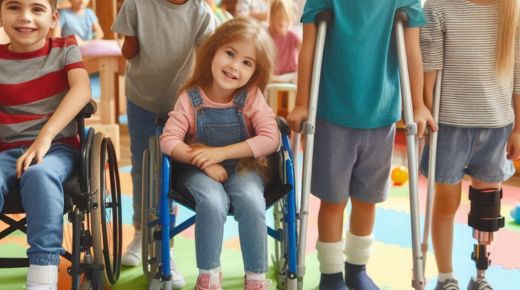Cerebral Palsy: How Early Rehabilitation Makes a Difference
Cerebral palsy (CP) is a group of neurological disorders that affect movement, posture, and muscle coordination due to brain development issues or damage. It is often diagnosed in infancy or early childhood and can vary significantly in severity and symptoms. While there is no cure for cerebral palsy, early rehabilitation plays a crucial role in improving the quality of life for affected individuals. This article explores the importance of early rehabilitation in cerebral palsy treatment and how it can lead to significant improvements in functional abilities and overall well-being.
Understanding Cerebral Palsy
Cerebral palsy can manifest in various forms, affecting muscle control, coordination, and communication skills. Symptoms can include:
- Difficulty with voluntary movements
- Muscle stiffness or weakness (spasticity)
- Involuntary movements or tremors
- Problems with balance and posture
The impact of these symptoms can range from mild to severe, and early intervention is essential for maximizing potential and enhancing independence.
The Importance of Early Rehabilitation1. Timely Intervention
Early rehabilitation for cerebral palsy typically begins as soon as a diagnosis is made, often in the first few months or years of life. Timely intervention is crucial because the brain is most receptive to change during early childhood. The earlier rehabilitation starts, the more effective it can be in promoting neuroplasticity—the brain’s ability to reorganize and form new connections.
2. Individualized Treatment Plans
One of the cornerstones of early rehabilitation is the development of individualized treatment plans tailored to each child’s unique needs. A multidisciplinary team, including physiotherapists, occupational therapists, speech therapists, and medical professionals, collaborates to create a comprehensive approach. This tailored strategy may include:
- Physical Therapy: Focused on improving motor skills, strength, and coordination.
- Occupational Therapy: Aimed at enhancing daily living skills and independence.
- Speech Therapy: Targeting communication skills and addressing any speech-related challenges.
By customizing treatment plans, rehabilitation can effectively address the specific challenges faced by each child with cerebral palsy.
3. Enhancing Mobility and Physical Function
One of the primary goals of early rehabilitation is to enhance mobility and physical function. Children with cerebral palsy often experience delays in reaching developmental milestones, such as crawling, walking, or running. Early intervention can significantly improve these abilities through:
- Strengthening Exercises: Building muscle strength in affected areas to promote movement.
- Balance and Coordination Training: Activities designed to improve stability and coordination.
- Gait Training: Helping children learn to walk independently or with the aid of assistive devices.
Improving mobility not only enhances physical independence but also fosters confidence and a sense of accomplishment in children.
4. Addressing Communication and Social Skills
Cerebral palsy can also affect communication and social interaction. Early rehabilitation often includes speech and language therapy to support effective communication skills. This may involve:
- Speech Exercises: Focusing on articulation, language comprehension, and expressive language skills.
- Augmentative Communication Devices: Utilizing tools such as communication boards or speech-generating devices for those with severe communication challenges.
By enhancing communication abilities, children with cerebral palsy can engage more fully in social interactions, improving their relationships with peers and family.
5. Promoting Cognitive Development
Early rehabilitation is not solely focused on physical and communication skills; it also plays a significant role in promoting cognitive development. Engaging children in cognitive activities, problem-solving exercises, and interactive play can stimulate brain development.
Therapists often incorporate games and activities that challenge cognitive skills, helping children develop critical thinking, memory, and attention. This holistic approach ensures that rehabilitation addresses the full spectrum of a child’s development.
6. Building a Supportive Environment
Early rehabilitation helps create a supportive environment for children with cerebral palsy and their families. Involving family members in the rehabilitation process is crucial, as they play an essential role in supporting their child’s progress.
Therapists educate families about cerebral palsy, its implications, and effective strategies for promoting development at home. This education fosters a sense of empowerment for families, enabling them to advocate for their child’s needs and provide necessary support.
7. Improving Long-Term Outcomes
Research has shown that children who receive early rehabilitation for cerebral palsy have better long-term outcomes than those who do not. Early intervention can lead to:
- Greater Independence: Children are more likely to achieve milestones related to mobility, self-care, and daily living skills.
- Enhanced Quality of Life: With improved physical and social abilities, children can engage more fully in their communities, leading to a richer, more fulfilling life.
- Reduced Need for Intensive Interventions: Early rehabilitation can decrease the severity of symptoms over time, potentially reducing the need for more intensive interventions later in life.
Early rehabilitation is a crucial aspect of cerebral palsy treatment that can significantly impact the lives of affected individuals. By providing timely, individualized interventions focused on enhancing mobility, communication, cognitive development, and overall well-being, early rehabilitation sets the stage for a brighter future.
Families, healthcare professionals, and educators must work together to ensure that children with cerebral palsy receive the support they need as early as possible. Through collaborative efforts and early intervention, we can empower children with cerebral palsy to reach their full potential and lead fulfilling, independent lives. Some hospices and homes for elderly offer rehabilitation and care.

